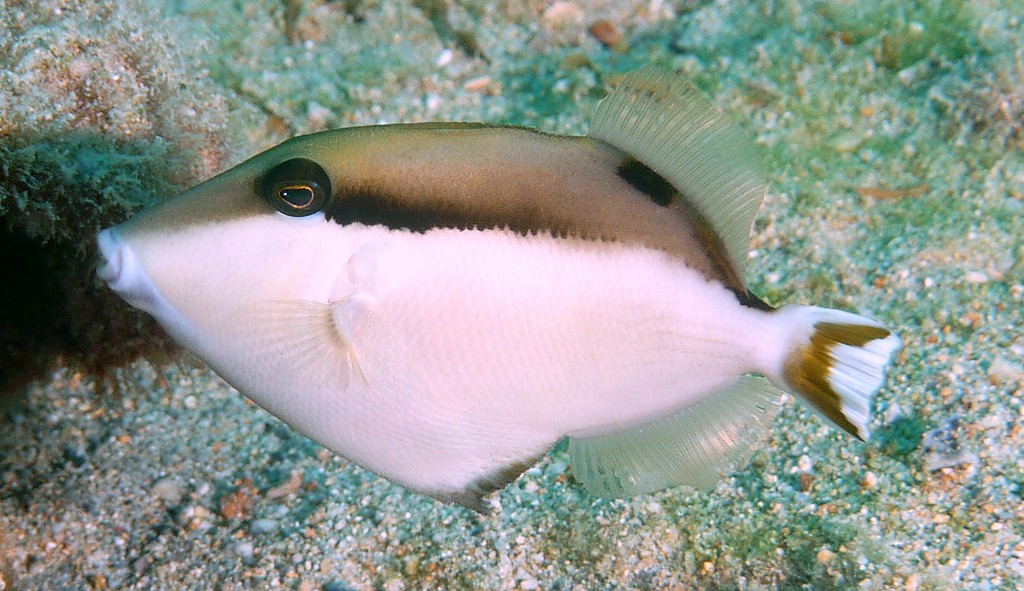SUFFLAMEN CHRYSOPTERUM - (BLOCH & SCHNEIDER, 1801)
Picture courtesy of: Gloup Noumea
Actinopterygii (Gigaclass) > Actinopteri (Class) > Teleostei (Subclass) > Tetraodontiformes (Order) > Balistoidei (Suborder) > Balistidae (Family) > Sufflamen (Genus)Baliste demi-lune, Baliste double-queue, Black triggerfish, Flagtail triggerfish, Goldenfinned triggerfish, Goldenlined triggerfish, Half-moon triggerfish, Halfmoon triggerfish, Yellowstreak triggerfish, Whitetail Trigger, Eye-stripe Triggerfish, whitetip triggerfish, Halfmaan-snellervis, Halvmåneaftrækkerfisk, Drückerfisch, Porco meia-lua, Tsumajiromongara,
Description
Épines dorsales (Total): 3; Rayons mous dorsaux (Total): 26-28; Épines anales 0; Rayons mous anaux: 23 - 26. Le baliste demi-lune adulte a une livrée brune à bleu foncé. Sa tête est allongée avec des lèvres de couleur crème. Un anneau bleu entoure sa bouche dont le dessous est teinté de bleu également. A l'arrière de l'oeil, une ligne verticale claire se prolonge jusqu'à la nageoire pectorale. La nageoire caudale est jaune brun bordée de blanc. Le juvénile est brun clair sur le haut du flanc et blanc sur le reste du corps. En phase intermédiaire, il est gris clair. Taille max. : 30.0 cm TL. Profondeur 1 - 30 m.
Etymologie
Sufflamen : du Latin, sufflamen = obstacle, (entrave), ce à quoi on se heurte à l'exécution d'un projet, sabot pour enrayer. En 1916 David Starr Jordan, pédagogue, naturaliste et écrivain américain, choisi ce mon car le Dr Samuel Latham Mitchill (1764-1831) appelait de cette manière les "gâchettes (nageaoire dorsale)" de ces poissons.
chrysopterum : du Grec ancien, chryso- + pterus = topaze, pierre précieuse tacheté d'or. Ici le nom s'applique a la queue jaune du poisson.
Description originale : Balistes chrysopterus Bloch & Schneider, 1801 - Localité type : côte de Coromandel, portion du littoral de l'Inde baignée par le golfe du Bengale, dans l'océan Indien. Elle est située sur la côte du sud-est de la péninsule indienne, entre le delta du Krishnâ au nord et la pointe Calimere dans le delta de la Kâverî au sud, et constitue une partie du rivage des États du Tamil Nadu et de l'Andhra Pradesh.
Distribution
Indo-pacifique de l'Est de Afrique, Afrique du Sud, Canal du Mozambique, Seychelles, Madagascar, Mascareignes, jusqu'au Samoa, Sud de l'Australie, Ile Lord Howe, Nouvelle-Calédonie, du Nord au Sud du Japon et Iles Ogasawara.
Biologie
Ces poissons balistes vivent souvent seuls, proche des zones sablonneuses et des récifs coralliens. Ils se nourrissent d'oursins, de mollusques et de petits crustacés.
Espèce ressemblante
Sufflamen albicaudatum (Rüppell, 1829) - Présent en Mer Rouge, dans le Nord-Est de l'Océan Indien, et dans la Golfe d'Oman.
Synonymes
Balistes chrysopterus (Bloch & Schneider, 1801)
Balistes mungopark (Lacepède, 1802)
Balistes niger (Park, 1797)
Balistes subarmatus (Gray, 1831)
Hemibalistes chrysoptera (Bloch & Schneider, 1801)
Hemibalistes chrysopterus (Bloch & Schneider, 1801)
Sufflamen chrysoptera (Bloch & Schneider, 1801)
Sufflamen chrysopterus (Bloch & Schneider, 1801)
----------------------------------------------
Description
Dorsal spines (total): 3; Dorsal soft rays (total): 26-28; Anal spines: 0; Anal soft rays: 23 - 26. Juveniles dark brown above, white below. Adult variable in color; the bar running through the pectoral base can either be yellow or black, and some individuals may be largely yellowish posteriorly. Max length : 30.0 cm. Depth range 1 - 30 m.
Etymology
Sufflamen: from Latin, sufflamen = clog, impediment. Sufflamen (impediment) is a word used by Dr Samuel Latham Mitchill (1764-1831) for the "trigger" of these "Trigger Fishes." David Starr Jordan, 1916.
chrysopterum: from Ancient Greek, chryso- + pterus = golden-winged.
Original descripition: Balistes chrysopterus Bloch & Schneider, 1801 - Type locality: Coromandel Coast, India.
Distribution
East Africa, South Africa, Mozambique Channel, Seychelles, Madagascar and Mascarenes east to Samoa, north to southern Japan and Ogasawara Islands, south to Australia, Lord Howe Island and New Caledonia.
Biology
Inhabit coastal to outer reefs. Habitats from silty lagoons to pristine outer reef walls. Occur in shallow lagoon and seaward reefs. Solitary and territorial. Feed on a wide variety of invertebrates. Minor importance to fisheries, taken by drive-in nets, gill nets, and traps. Oviparous. Monogamous. Male defends a defined territory, within which a female resides. On the day prior to spawning, female pushes her snout into the sandy bottom repeatedly and removes small stones and pieces of coral at several sites. Adhesive eggs are deposited on the sandy bottoms or in a small cavity of the reef covered with sand. Female fans the eggs and defends the nest, while male patrols around female.
Similar species
Sufflamen albicaudatum (Rüppell, 1829) - Red Sea, northwestern Indian Ocean: Gulf of Oman.
Original descripition: Balistes chrysopterus Bloch & Schneider, 1801 - Type locality: Coromandel Coast, India.
Distribution
East Africa, South Africa, Mozambique Channel, Seychelles, Madagascar and Mascarenes east to Samoa, north to southern Japan and Ogasawara Islands, south to Australia, Lord Howe Island and New Caledonia.
Biology
Inhabit coastal to outer reefs. Habitats from silty lagoons to pristine outer reef walls. Occur in shallow lagoon and seaward reefs. Solitary and territorial. Feed on a wide variety of invertebrates. Minor importance to fisheries, taken by drive-in nets, gill nets, and traps. Oviparous. Monogamous. Male defends a defined territory, within which a female resides. On the day prior to spawning, female pushes her snout into the sandy bottom repeatedly and removes small stones and pieces of coral at several sites. Adhesive eggs are deposited on the sandy bottoms or in a small cavity of the reef covered with sand. Female fans the eggs and defends the nest, while male patrols around female.
Similar species
Sufflamen albicaudatum (Rüppell, 1829) - Red Sea, northwestern Indian Ocean: Gulf of Oman.
